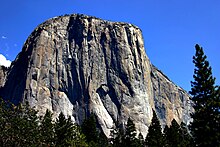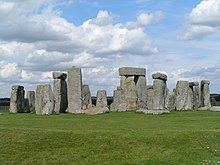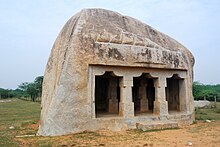monolith
Monolith ( ancient Greek μονόλιθος monólithos , German 'uniform stone' or literally 'one stone', from μονο- mono- 'single' and λίθος líthos 'stone') is a more general term for a naturally created or worked stone block, the consists entirely of the same type of rock.
The corresponding adjective monolithic is also used in a figurative sense and then usually means something like “compact”, “from one piece” or “synchronized”.
Natural "monoliths"

The word “monolith” can be found in various contexts in scientific and popular scientific literature, and in English-speaking countries also in publications with a focus on geology or geomorphology . However, it is not indexed in numerous geological dictionaries. The fifth edition of the Glossary of Geology (2011) gives the following meanings:
- A piece of rock without cracks or fractures, the dimensions of which generally exceed several meters, for example an unweathered boulder
- A large, towering mass of rock, such as a lava needle
- One of several large stone blocks that form the components of a structure (see below )
- In Soil Science , a vertical profile that is customized to the sequence of soil horizons show *
The first two meanings of the word, which are directly related to geology and geomorphology, are reflected in the designation of several geographical objects as "monoliths" which, apart from relatively steep walls and a flat summit plateau, have little in common. This includes:
-
Inselbergs
-
Uluṟu (Ayers Rock), Northern Territory, Australia:
- consists of steep provided sandstone layers
- has an approximately round floor plan that is large in relation to the height and a correspondingly large summit plateau
-
Mount Augustus , Western Australia, Australia:
- consists of sandstone and other rocks that form an anticline structure
- is more of an elongated back
-
Devils Tower , Wyoming, USA:
- consists of columnar fissured phonolite
- has an approximately round floor plan that is small in relation to the height and a correspondingly small summit plateau
-
Uluṟu (Ayers Rock), Northern Territory, Australia:
-
Rock towers within a mountain country
-
Angels Landing and Great White Throne in Utah, USA
- both consist of horizontally lying sandstone layers
-
Angels Landing and Great White Throne in Utah, USA
- other objects:
- El Capitan , California, USA, a prominent ledge in the granitic north face of the Merced River Valley ( Yosemite National Park )
- The Phobos monolith , a large block on the Martian moon Phobos , about which nothing more is actually known
On closer inspection, however, the term “monolith” is rather unsuitable for some of these objects. Mount Augustus and possibly also the Phobos monolith consists of more than one type of rock, the rock of the Devils Tower is strongly fissured and El Capitan is not a really independent morphological structure. In addition, the term “monolith” is mainly used in archeology , where it usually refers to hewn natural stone objects broken out of the natural rock (see below ). Because of this lack of definition and ambiguity, “monolith” as a geological-geomorphological term should be avoided if possible.
Man-made or machined monoliths
The terms “monolith” or “monolithic” are used not only for natural objects, but also in particular for objects created by human hands or at least modified, such as for
- the megaliths handed down from the Neolithic and Bronze Ages (including menhirs and the supporting stones or capstones of dolmens etc.),
- the detailed statuary menhirs , obelisks and columns of younger and more highly developed cultures,
- Architrave blocks , fonts, etc.
The Buddha statues from the Bamiyan valley (Afghanistan), the Jain statue Bahubalis from Shravanabelagola (India), the colossal heads of the Olmecs from Veracruz (Mexico), the moais from Easter Island and the presidential heads from Mount Rushmore (USA) are also regular described as "monolith" or "monolithic".
In modern construction are all in fact reinforced concrete components as monolithic components referred to, as they are cast in one piece (see also → Monolithic Dome ). Connections between two such components are called monolithic connection or monolithic connection . The terms “monolith” or “monolithic” are also sometimes used for art and everyday objects made of “cast concrete”.
Further uses of the terms "monolith" and "monolithic"
- Monolithic kernels are operating system kernels (e.g. with older Linux versions) whose individual components (device drivers, file systems, function extensions, etc.) are located in a common, not separate or protected area. In comparison to this, microkernel systems try to organize their individual components (kernel modules) separately from one another in independent protected units (e.g. GNU Hurd, L4). Modern kernels are predominantly hybrids of both concepts (e.g. current Linux, Windows NT, Darwin).
- Integrated circuits that are built on a single (silicon) crystal (chip) are called monolithic - in contrast to e.g. B. for thick-film hybrid technology .
- In liquid chromatography , stationary phases are referred to as monolithic or monoliths if they do not consist of many densely packed, individual non-porous or porous particles, but of a single piece of highly porous material (e.g. silica gel or an organic polymer ).
- In space travel, space stations are said to be monolithic when they consist of a single unit, which was the case with early and relatively small space stations like those of the Soviet Salyut series. More modern and larger space stations like the Mir or the ISS , on the other hand, were or are modular in structure.
- Parties or organizations can be described as monolithic. This suggests indolence, conservatism and long-standing decision-making structures. In this sense, Josef Stalin is now regarded as a “colossus of power” and his system as “monolithic”. The CDU was also described in the literature as a monolithic unit of action; however, this was rejected by Josef Schmid .
Popular culture
In the novel and film 2001: A Space Odyssey by Arthur C. Clarke and Stanley Kubrick , a black, perfect cuboid monolith, the edges of which have a length ratio of 1: 4: 9, can be interpreted as a symbol of extraterrestrial intelligence. As an allusion to this, several video games that focus on the colonization of planets or moons use a type of monolith to indicate that intelligent life had been there. For example, in the last phase of the evolution-based video game Spore, you can place a monolith on a planet populated by primitive life forms in order to bring them faster into the space age.
At the Swiss national exhibition Expo.02 in the Three Lakes Region , the French architect Jean Nouvel installed a walk-in sheet steel cube with an edge length of 34 meters in Lake Murten and named it “Monolith”.
literature
- Robert P. Bourman, Clifford D. Ollier, Solomon Buckman: Inselbergs and monoliths: a comparative review of two iconic Australian landforms, Uluru (Ayers Rock) and Burringurrah (Mount Augustus). In: Journal of Geomorphology. Volume 59, No. 2, 2015, pp. 197-227, doi: 10.1127 / 0372-8854 / 2014/0148 , (alternative full-text access : ResearchGate ).
Individual evidence
- ↑ Hans-Peter Blume, Karl Stahr, Peter Leinweber: Soil Science Practical - An introduction to pedological work for ecologists, farmers and foresters, geologists and environmental scientists. Spektrum Akademischer Verlag, Heidelberg 2010, ISBN 978-3-8274-1553-0 , p. 60.
- ↑ Veronika R. Meyer: Practice of high-performance liquid chromatography. 10., completely revised. and exp. Edition. Wiley-VCH, Weinheim 2008, ISBN 978-3-527-32046-2 , p. 114 ff.
- ^ Josef Schmid: Expert survey and information meeting in party research: How federal is the CDU? In: Ulrich von Alemann (Hrsg.): Political science methods - outline for study and research. Springer, Berlin / Heidelberg 1995, pp. 293-326, doi : 10.1007 / 978-3-663-05982-0_6 .
- ↑ main developer Will Wright speaks in this TED Talk Will Wright: Spore, birth of a game at [1]



